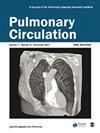Cardiac effort and 6-min walk distance correlate with stroke volume measured by cardiac magnetic resonance imaging
IF 2.5
4区 医学
Q2 CARDIAC & CARDIOVASCULAR SYSTEMS
引用次数: 0
Abstract
Right ventricular (RV) dysfunction in pulmonary arterial hypertension (PAH) is associated with poor outcomes. Cardiac magnetic resonance imaging (cMRI) is the gold standard for volumetric assessment, and few reports have correlated 6-min walk distance (6MWD) and cMRI parameters in PAH. Cardiac Effort, (the number of heart beats used during 6-min walk test)/(6MWD), incorporates physiologic changes into walk distance and has been associated with stroke volume (SV) measured by nuclear imaging and indirect Fick. Here, we aimed to interrogate the relationship of Cardiac Effort and 6MWD with SV measured by the gold standard, cMRI. This was a single-center, observational, prospective study in Group 1 PAH patients. Subjects completed 6-min walk with heart rate monitoring (Cardiac Effort) and cMRI within 24 h. cMRI was correlated to Cardiac Effort and 6MWD using Spearman Correlation Coefficient. Twenty-five participants with a wide range of RV function completed both cMRI and Cardiac Effort. There was a strong correlation between left ventricle SV index and both Cardiac Effort (r = −0.70, p = 0.0001) and 6MWD (r = 0.67, p = 0.0002). Cardiac Effort and 6MWD were statistically separated in patients at prognostically significant thresholds of left ventricle SV index (>31 ml/m2), RV Ejection Fraction (>35%), and SV/End Systolic Volume ( > 0.53). Cardiac Effort and 6MWD are noninvasive ways to gain insight into those with impaired SV. 6MWD may correlate better with SV than previously thought and heart rate monitoring provides physiologic context to the walk distance obtained.心力和 6 分钟步行距离与心脏磁共振成像测量的脑卒中体积相关
肺动脉高压(PAH)患者的右心室(RV)功能障碍与不良预后有关。心脏磁共振成像(cMRI)是容积评估的黄金标准,但很少有报告将 PAH 患者的 6 分钟步行距离(6MWD)和 cMRI 参数联系起来。心脏负荷(6 分钟步行测试中使用的心跳次数)/(6MWD)将生理变化纳入步行距离,并与核成像和间接 Fick 测量的搏出量(SV)相关。在此,我们旨在研究心脏负荷和 6MWD 与 cMRI 这一黄金标准测量的 SV 之间的关系。这是一项针对第一组 PAH 患者的单中心前瞻性观察研究。受试者在 24 小时内完成了带有心率监测的 6 分钟步行(Cardiac Effort)和 cMRI。cMRI 与 Cardiac Effort 和 6MWD 采用 Spearman 相关系数进行相关性分析。25 名具有不同 RV 功能的参与者同时完成了 cMRI 和心脏负荷。左心室 SV 指数与心脏负荷(r = -0.70,p = 0.0001)和 6MWD (r = 0.67,p = 0.0002)之间存在很强的相关性。在左心室 SV 指数(31 ml/m2)、RV 射血分数(35%)和 SV/收缩末期容积(0.53)达到显著预后阈值的患者中,心脏负荷和 6MWD 在统计学上存在差异。心脏用力和 6MWD 是了解 SV 受损患者的无创方法。6MWD 与 SV 的相关性可能比以前认为的要好,心率监测为获得步行距离提供了生理背景。
本文章由计算机程序翻译,如有差异,请以英文原文为准。
求助全文
约1分钟内获得全文
求助全文
来源期刊

Pulmonary Circulation
Medicine-Pulmonary and Respiratory Medicine
CiteScore
4.20
自引率
11.50%
发文量
153
审稿时长
15 weeks
期刊介绍:
Pulmonary Circulation''s main goal is to encourage basic, translational, and clinical research by investigators, physician-scientists, and clinicans, in the hope of increasing survival rates for pulmonary hypertension and other pulmonary vascular diseases worldwide, and developing new therapeutic approaches for the diseases. Freely available online, Pulmonary Circulation allows diverse knowledge of research, techniques, and case studies to reach a wide readership of specialists in order to improve patient care and treatment outcomes.
 求助内容:
求助内容: 应助结果提醒方式:
应助结果提醒方式:


